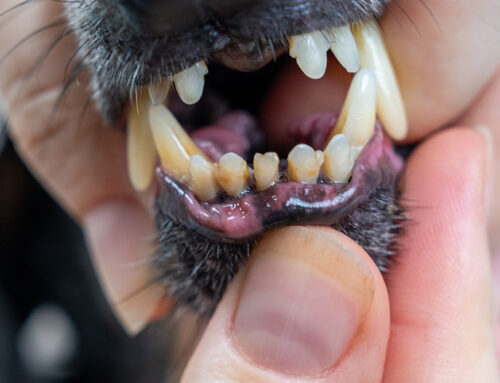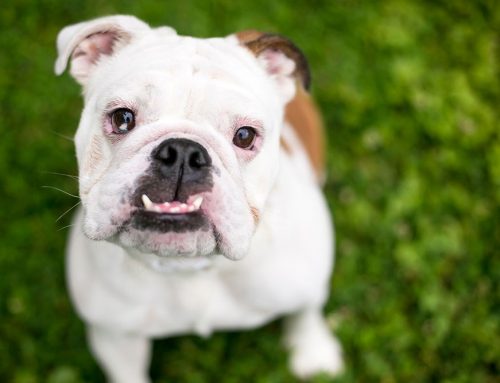Overbites, or Class 2 malocclusions, occur when the upper jaw is significantly longer than the upper jaw, which can lead to discomfort, difficulty eating, and other oral health issues. Fortunately, pets with this condition have several treatment options, each with its own benefits and drawbacks. Our North Bay Veterinary Dentistry team outlines the various overbite treatments available for cats and dogs, helping you make informed decisions regarding your furry friend’s oral health.
Common problems associated with overbites in pets
Overbites in pets can lead to several significant health issues. The primary problems include pain and discomfort, as the misaligned teeth press into the hard palate, causing chronic pain and potentially associated behavioral changes. The lower canine teeth contacting the upper jaw soft tissues and teeth can result in severe damage that requires surgery to correct if not addressed early on.
The most common problem associated with an overbite is the trauma caused by the lower canines on the roof of the mouth- this trauma can create ulcers and oronasal fistulae ( holes between the oral and nasal cavities), leading to infection, severe pain, and chronic nasal infections. Misaligned teeth are also difficult to clean, increasing a pet’s plaque buildup and gum disease risks. Early detection and treatment are crucial to prevent these complications and ensure your pet’s well-being.
Treatment options for overbites in pets
Treating your pet’s overbite focuses on removing or changing the location of the teeth related to the malocclusion that are causing pain, trauma, or difficulty eating. In some cases, therapies are combined to fully correct the issue.
Deciduous teeth extraction for pets
For deciduous—baby—teeth that are traumatizing the palate, extraction is often the most practical solution. The procedure must be performed carefully to avoid damaging the developing permanent teeth, which are often immediately adjacent to the root of the baby tooth.
The immediate relief provided by extracting the problematic baby teeth prevents further damage to the palate and gives permanent teeth the potential to erupt into a more normal position. However, care must be taken to avoid leaving root remnants, which could affect the positioning of the permanent teeth. Postoperative radiography verifies complete extraction.
Orthodontic movement for pets
Orthodontic movement involves using devices to gradually move teeth into more comfortable positions. These devices can include braces, inclined planes, and temporary crown extensions. This method is non-invasive, and though it requires a relatively long treatment phase, results in a pain-free and healthy mouth without damage to any of the adult teeth present.
Orthodontic devices are custom-made to fit your pet’s specific dental needs. These devices require regular adjustment and maintenance, and this treatment’s success depends on how well your pet tolerates the treatment and your dedication to their therapy. To successfully move teeth, treatment can be lengthy, often requiring several months to achieve the desired results.
Crown amputation and root canal for pets
If your pet’s permanent teeth are traumatizing their palate, crown amputation with a partial or full root canal can be an effective treatment. This method involves removing a portion of the tooth to prevent it from impacting the mouth’s soft tissues, followed by a root canal to preserve the health of the root of the tooth. The crown amputation alleviates pain and discomfort, while the root canal preserves the tooth’s vitality and function.
Although this treatment provides immediate relief, the procedure is complex and requires a skilled veterinary dentist—like Dr. Fulton—to perform the procedure and monitor healing. Regular follow-ups throughout your pet’s life help guarantee the root canal’s success and the tooth’s continued health. If the procedure is not performed correctly, a complication, such as infection or tooth pulp damage, can develop.
Extracting adult teeth
In some patients, the most ideal treatment for a malocclusion is removing the problem tooth. This can be the case when a tooth is partially erupted, a smaller unimportant to function tooth, or when there is simply not enough room for the tooth to fit appropriately without causing pain and trauma. Though this is the most invasive type of treatment, it also results in a permanent resolution to the problem.
Combination treatments for pets
In many cases, a combination of the above methods may be the best approach to treat pets’ overbites. For example, extracting obstructing teeth and using orthodontic devices can be effective in addressing individual variations in dental alignment. This approach offers a comprehensive solution by addressing all of an overbite’s multiple aspects, providing a thorough treatment plan tailored to your pet’s specific needs. While this method increases the likelihood of success, it requires careful planning and coordination between different treatment methods.
Each treatment has benefits and drawbacks, and the best choice depends on the overbite’s severity, your pet’s overall health, and your preferences and resources. Schedule a consultation with our North Bay Veterinary Dentistry team to determine the best course of action for your furry friend’s overbite.






Leave A Comment